Caltech
In high school, Berry scored a perfect 800 on the quantitative SAT test while finishing in half the allotted time. Caltech, MIT, and Reed College accepted him. He chose Caltech.
Berry received his BS degree in Engineering from Caltech in 1957, where he studied under teachers like Dr. Linus Pauling. Pauling stressed problem solving. Exams at Caltech were open book because that is how the real-world works. They challenged the students to find a solution to a problem in a limited time using as many resources as you can, without cheating.
After his freshman year at Caltech, the Selective Service required Berry to take its examination. Berry finished the 2-hour written test in one hour. The Sargent graded Berry’s exam with a template and found no errors. The Sargent reviewed Berry’s exam a second and a third time, and said, “This is impossible. I have been scoring these exams for 20 years and no one ever gets a perfect score.”
While at Caltech, Berry was in the Air Force ROTC as a pilot trainee. The four years of officer training were valuable to his education. A week before graduation, Congress lowered the Air Force quota for pilots. So, the Air Force offered all AFROTC pilot trainees two choices: draw straws to see who gets to fly a jet and who gets to fly a desk or receive an honorable discharge from the Air Force. Berry choose the honorable discharge because he did not like the about 50% chance of flying a desk.
Gordon Fullerton was in the 1957 Caltech AFROTC class with Berry. Fullerton became an Air Force pilot and went on to pilot space shuttles. Maybe Berry’s decision left space for Fullerton to live his dream. Harrison Schmitt, Caltech 1957, was not in the AFROTC, but he walked on the moon. Frank Borman received his MS from Caltech in 1957.
Berry worked one year as a physics instructor at Sacramento State University and did graduate study in math. He saw a Dartmouth College announcement for six Graduate Teaching Fellowships in Physics. He applied and was one of the six accepted.
Dartmouth
As a Teaching Fellow in Physics, Berry also studied math, probability, and philosophy of science under Dr. John Kemeny who was Chairman of both math and philosophy departments. Berry and a few other students hung out in the evenings with Kemeny and his LPG-30 computer. Berry watched Kemeny develop the Basic computer language. (Kemeny, while a student at Princeton, worked on the Manhattan Project at Los Alamos National Laboratory under Richard Feynman and John von Neumann. Later, as a graduate student, Kemeny worked as a special mathematical assistant for Albert Einstein.)
Berry did his M.A. thesis on the transmission of high-frequency radio waves in the ionosphere under Dr. Millet Morgan. The study was a predecessor to HAARP. Berry received his MA degree in Physics from Dartmouth in 1960.
Nevada
Berry became the first research assistant for the Desert Research Institute at the University of Nevada, Reno, under Dr. Wendell Mordy, in 1961. Mordy brought in excellent scientists to mentor Berry: Dr. William T. Scott and Dr. Friedwart Winterberg who was the best student of Werner Heisenberg, Nobel Laureate in physics.
Scott taught Berry electrodynamics. Winterberg taught Berry fluid dynamics, magneto-hydrodynamics and relativity. They taught Berry more than physics. They taught Berry how masters think.
Berry received his PhD in Physics in 1965, with a focus on atmospheric physics and a minor in math. After graduation, Berry worked at the University of Nevada Desert Research Institute for seven years and was a consultant to the Naval Weapons Center in China Lake, California.
Berry is a Certified Consulting Meteorologist (#180) of the American Meteorological Society. He has published over 42 professional scientific papers. He is a pilot, with glider, power, and instrument ratings.
Climate physics
Berry’s theoretical PhD thesis is recognized as a breakthrough in atmospheric science and in the use of computer-based numerical models. He was the first to show how warm clouds can rain within 30 minutes. His numerical mathematical breakthrough allowed calculation of cloud droplet collisions and coalescence over a mass range of 12 orders of magnitude (with 1960’s computers). Cloud physics textbooks discuss Berry’s thesis.
Observations show that tropical clouds with no ice phase can produce rain within 30 minutes. Berry’s fundamental thesis problem was to develop a numerical model that properly simulates such rapid rain formation.
Berry was first to use a stochastic model in a numerical calculation. A Russian scientist (Golovin) had developed an analytic solution of the stochastic collection equation with one specific collection kernel. Scott, inspired by Berry’s thesis work, developed two more analytic solutions. But analytic solutions required assumptions that did not represent the realistic collection kernel for cloud droplet collection.
To produce a scientifically acceptable numerical model, Berry needed to demonstrate its accuracy. He did this by showing how his numerical model properly predicted the results of the three known analytic solutions of the stochastic collection equation. Fortunately, the three analytic solutions bounded the physics of real conditions.
Airborne research laboratory
After receiving his PhD degree in physics in 1965, Berry became chief scientist and manager of the Desert Research Institute’s airborne research facility. His research team included 16 people. One of their most memorable adventures was to measure the cloud characteristics of geysers. For additional information see Kim Berry’s website.
Flying through Old Faithful
On January 28 to 30, 1966, Berry took a 4-person crew to Idaho Falls in the DRI research Beechcraft C-45.
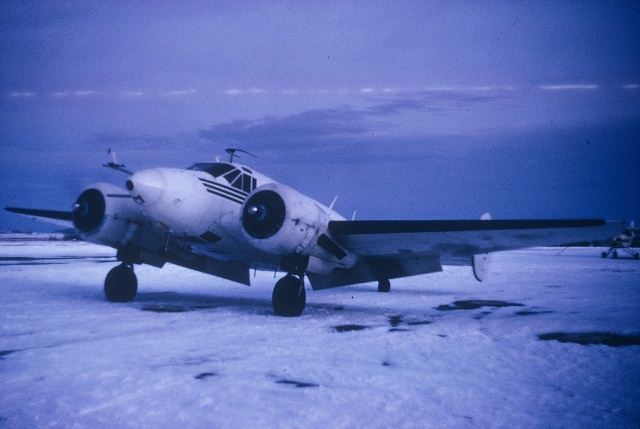
Above is the Desert Research Institute Beechcraft C-45 parked on the ramp in Idaho Falls. Notice the instrument pod extended from the nose of the aircraft.
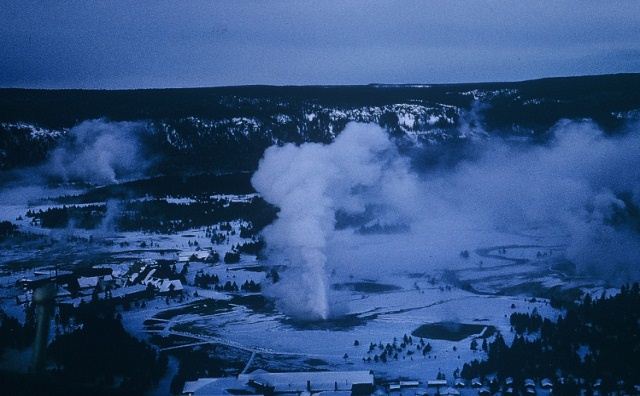
This photo was taken seconds before the DRI Beechcraft flew through Old Faithful Geyser in Yellowstone National Park, USA. The Beechcraft instrument pod is visible in the lower left corner of the photo. Tom Wells is pilot and Berry is copilot.
Berry’s team spent three days flying through geysers Yellowstone park. They took photos from a time-lapse 16 mm movie camera in the nose. On one very low pass through Old Faithful Geyser, the photos showed the aircraft was below the roof line of Old Faithful Lodge. This geyser penetration was so wet pass, it shut down the aircraft electrical system for 10 minutes.
Later, the Desert Research Institute upgraded its research aircraft to the modified B-26 shown here.
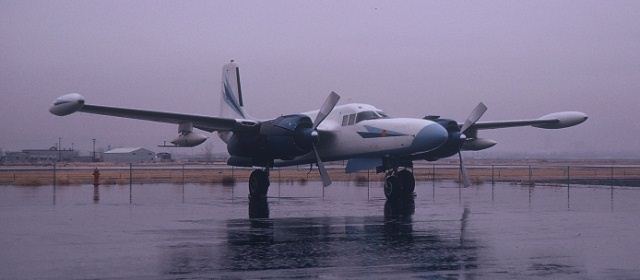
Berry led pioneering research flights inside Alberta hailstorms and Sierra Nevada storms.
Berry invented, and his team built, the first low cost, airborne, earth-referenced radar display. They adapted their system, first used in the B-26, to hurricane research. Berry proposed – since larger antennas make a better radar – to mount the antenna in the large door of a C-130, then to rotate the antenna, fly a 360-degree circle.

Air Force C-130 equipped with a large radar in place of its cargo door under the AIR FORCE letters. This produced a much more detailed radar image of a hurricane than ever before.
Project Popeye
In 1969, Dr. Pierre St. Amand, leader of weather modification research at the Naval Weapons Center at China Lake, California, invited Berry to be the only person outside DOD to participate in DOD’s Top-Secret Operation Popeye, now declassified. Popeye developed techniques to seed tropical clouds to produce rain for use over Laos and North Vietnam.
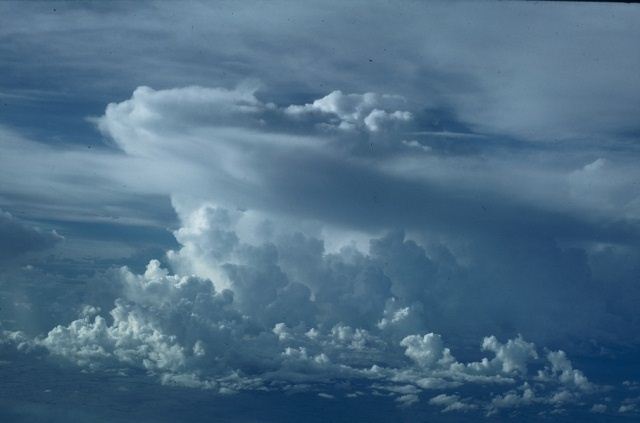
Picture shows a large cloud produced by dynamically seeding a group of small clouds.
Berry participated in meteorological research experiments in Canada, South Africa, Puerto Rico, St. Croix and the Philippine Islands.
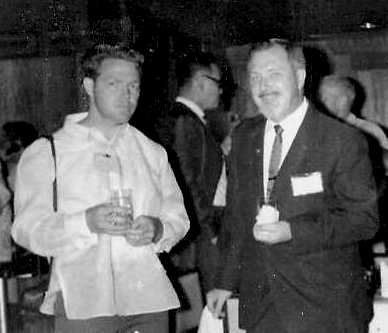
Dr. Ed and Dr. Pierre St. Amand at a formal reception in the Philippines.
Operating out of Clark AFB, St. Amand’s team used C-130’s to train B-52 pilots to seed certain clouds and make big storms. Later, the B-52 pilots used these methods to wash out the Ho Chi Min trail.
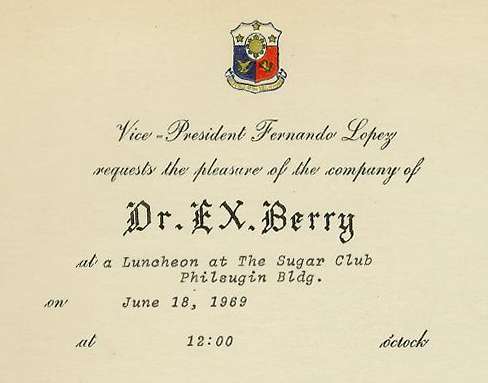
Invitation to the Vice-President’s luncheon
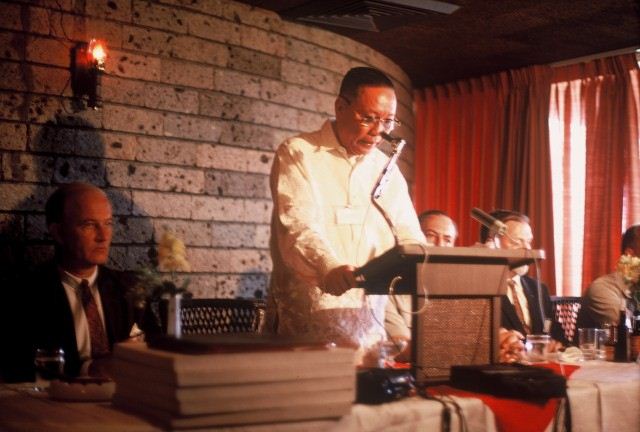
Vice-President Fernando Lopez hosts the luncheon.
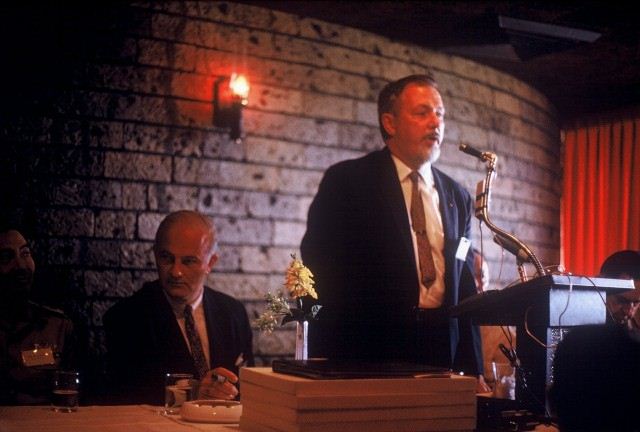
Dr. Pierre St. Amand speaks in behalf of America’s Department of Defense.
National Science Foundation
In 1973, National Science Foundation in Washington, DC invited Berry to be its Program Manager for Weather Modification. Berry managed NSF’s leading-edge national weather research projects, including the Metropolitan Meteorological Experiment (METROMEX) and the National Hail Research Experiment (NHRE).
METROMEX showed how a metropolitan city like St. Louis inadvertently changed its temperature, humidity and precipitation. This has become known as the heat island effect.
In 1974, Berry convened a panel of the best statisticians in America to review the statistical problems to determine whether cloud seeding caused the predicted modification. These eminent statisticians concluded this statistical problem was the most difficult statistical problem they had encountered.
This problem allowed experimenters to repeat their experiments and do double-blind studies. Yet, the experts concluded this problem is the most difficult statistical problem in the world, mainly because no one cloud is the same as another cloud.
In climate change studies, no one can repeat experiments, or have control experiments, or do double-blind studies. Today, global warming alarmists and university professors claim human emissions cause climate change. But their conclusions are not valid
Private business
In 1976, Berry founded Edwin X Berry & Associates in Sacramento, California, and grew it to employ 30 people.
On one project, Berry developed numerical models to calculate the effect of wind shear on departing and landing aircraft. He worked with pilots in Boeing simulators to determine what downdraft speeds were dangerous. Then Berry proposed a ground-based method to detect the presence of dangerous downdrafts, which the FAA installed at major airports. There seem to have been no wind shear caused accidents since.
Wind energy studies
Berry’s company performed the Southern California Desert wind-energy study for the California Energy Commission which mapped the available wind energy over an area the size of Ohio.
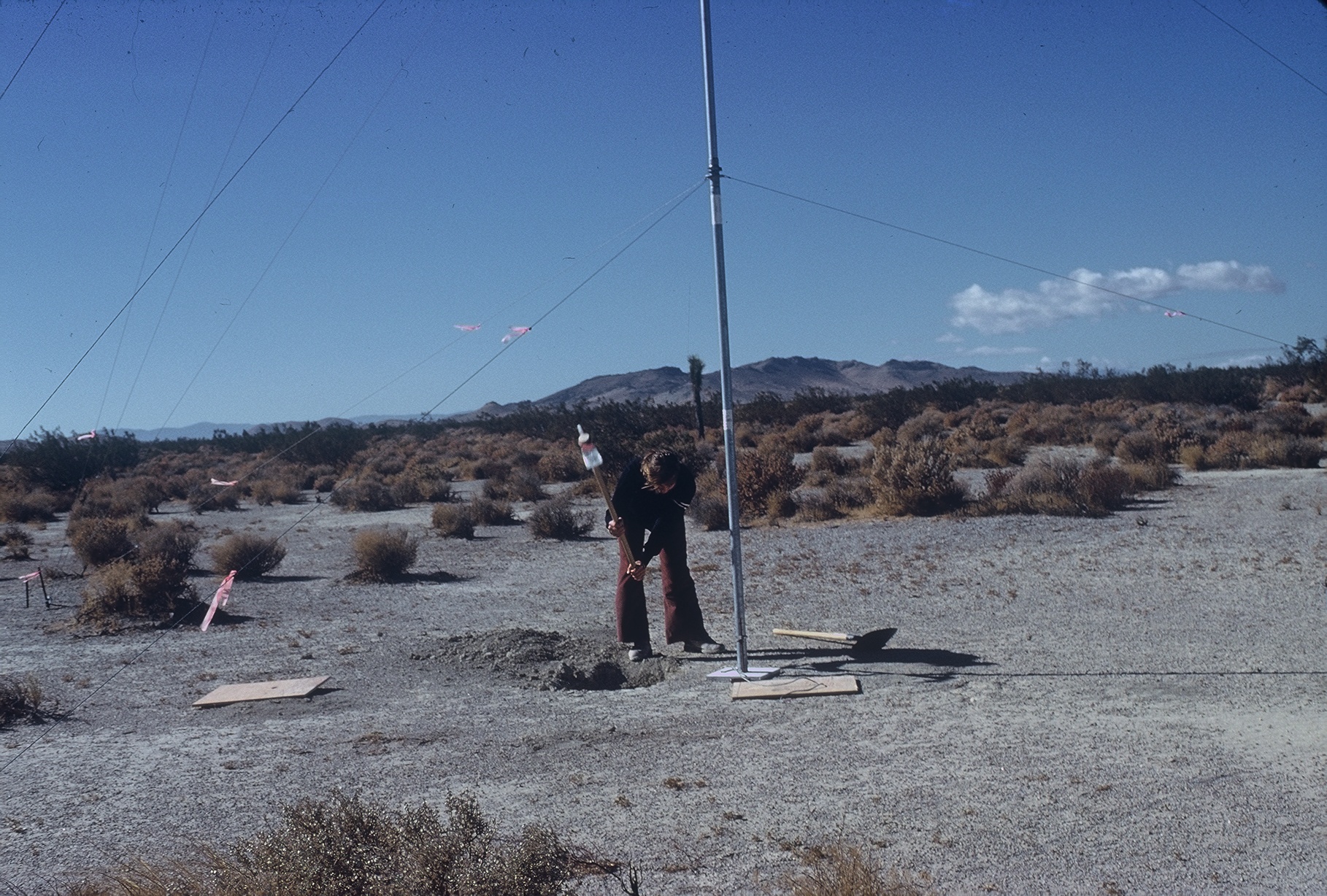
Berry’s company performed wind energy evaluations for many wind-energy companies. Berry was the first to identify Altamont Pass and Tehachapi Pass as excellent wind energy resources.
His company designed and manufactured the first low-cost, electronic remote data instruments for wind energy. Berry’s company developed easy to install 50-ft masts like this and installed them all over the southern California desert. Wind speed and direction sensors are at the top.
Here is their then state-of-the-art wind recording instrument. It recorded hourly average wind speed for 45 days without service, running on 4 D-cells. His team collected and processed the data monthly.
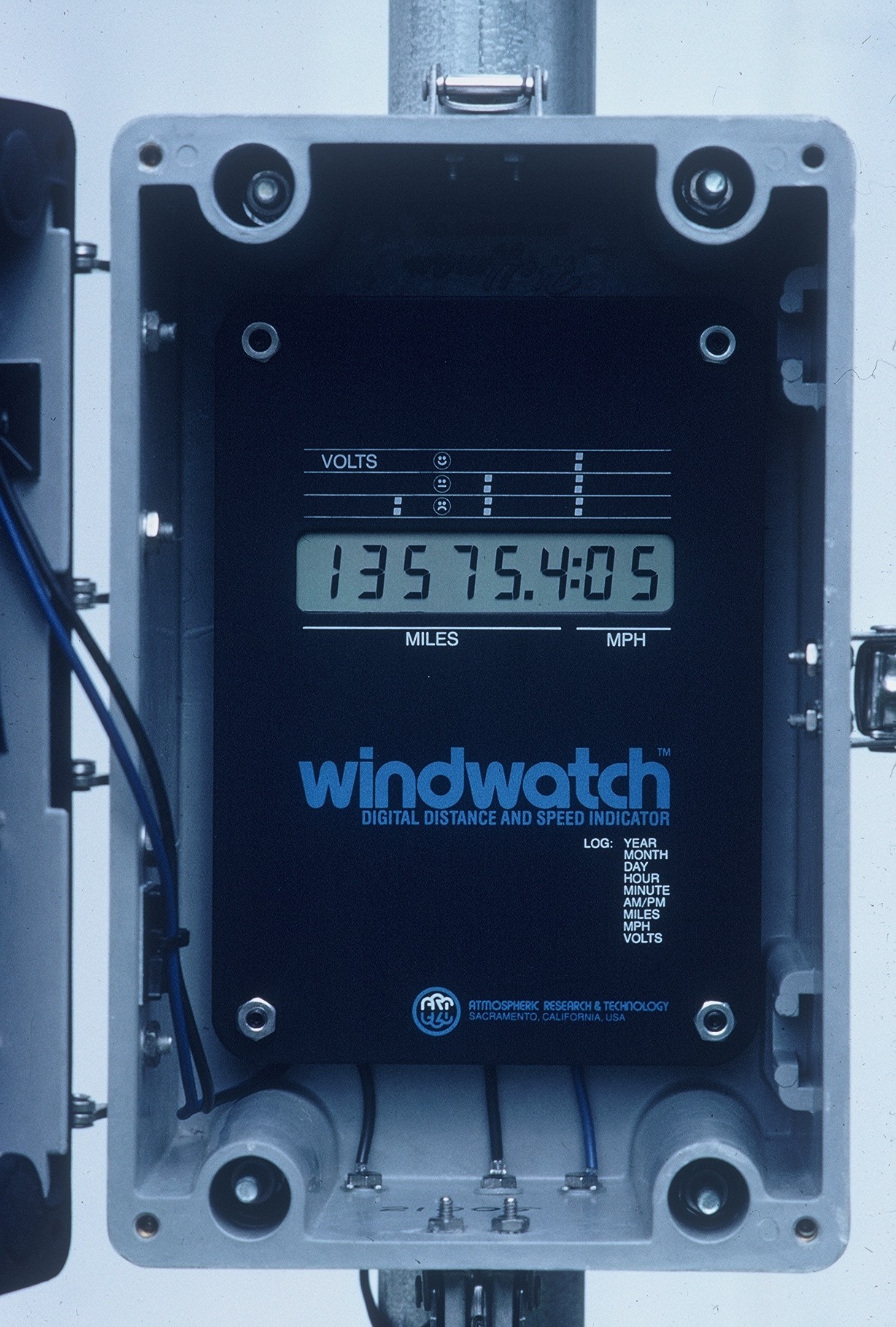
Berry’s company did many wind energy evaluations for private companies in California. Some of his competition came from non-scientists who called themselves environmentalists. These environmentalists believed they understood wind flow simply because they “cared for the earth.” Their incorrect wind evaluations cost the clients many millions of dollars. Among other errors, they thought wind is strongest on the windward side of the hill. The environmentalists did not understand fluid dynamics.
Below is a simulation of how wind flows over a smooth ridge. The wind is stronger on the leeward slope than on the windward side of the hill. This effect is even visible when water flows over rocks in a stream.
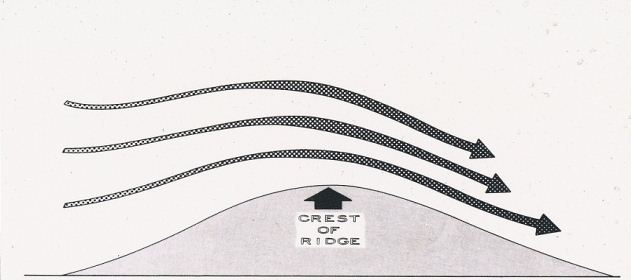
Eventually, wind companies concluded that Berry had the best education and experience – including skills in soaring and sailing – to make the best wind-energy assessments.
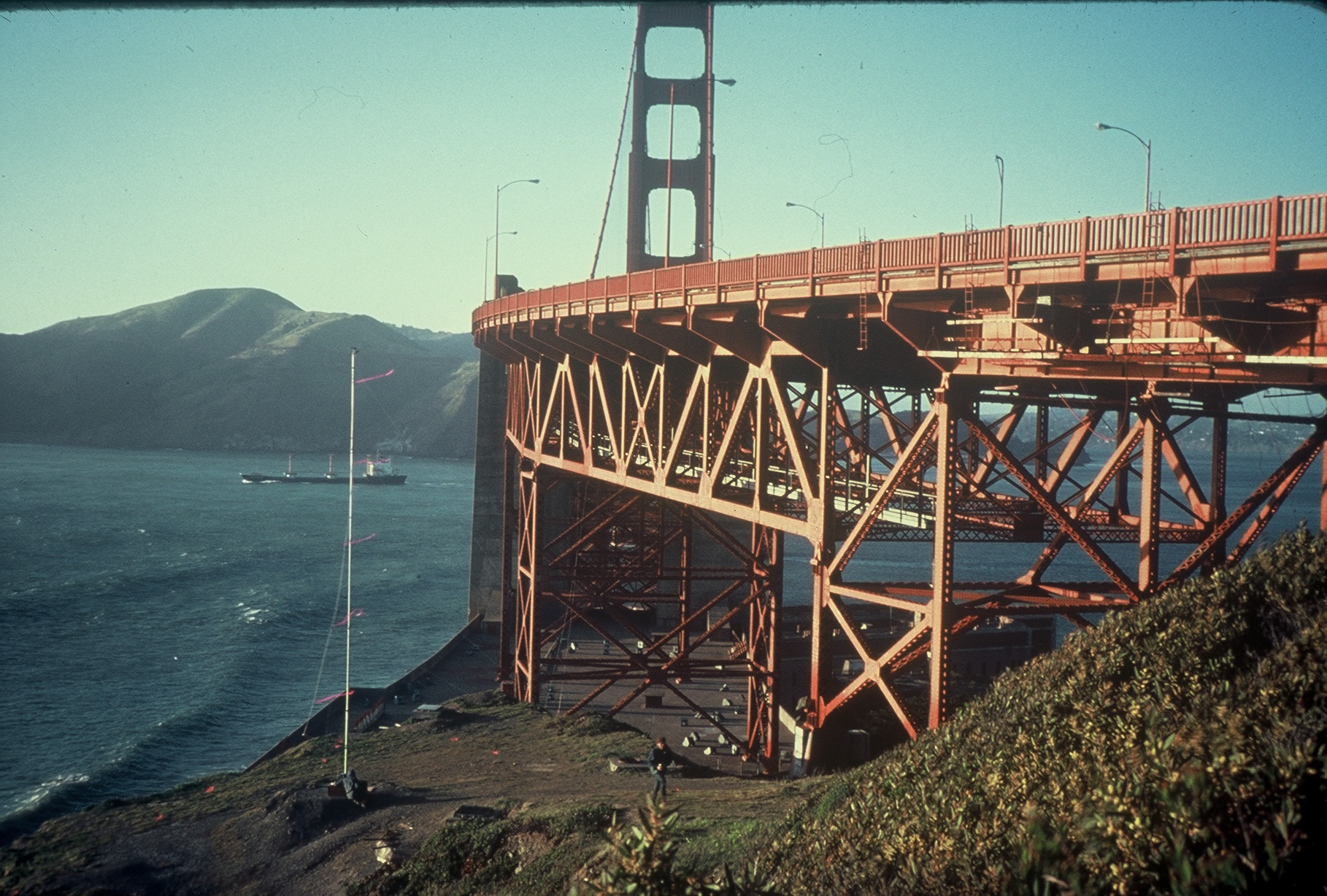
Above is the 50-ft mast with an anemometer that Berry’s company mounted at the south end of the Golden Gate Bridge.
Meteorological forecasting
From 1989 through 1992, Berry’s meteorological team provided 24-hour weather forecasting for the US Customs Aerostat project along the southern U.S. border.
Windows World Open ‘People’s Choice Award’
In 1992, Berry made courtroom history by developing and defending the first computer model to generate new evidence in a criminal trial. His custom software application, written in the first version of Microsoft Visual Basic, modeled human body physiological responses to changing weather and environmental conditions. His model and testimony were key in the successful defense in a high-profile murder trial.
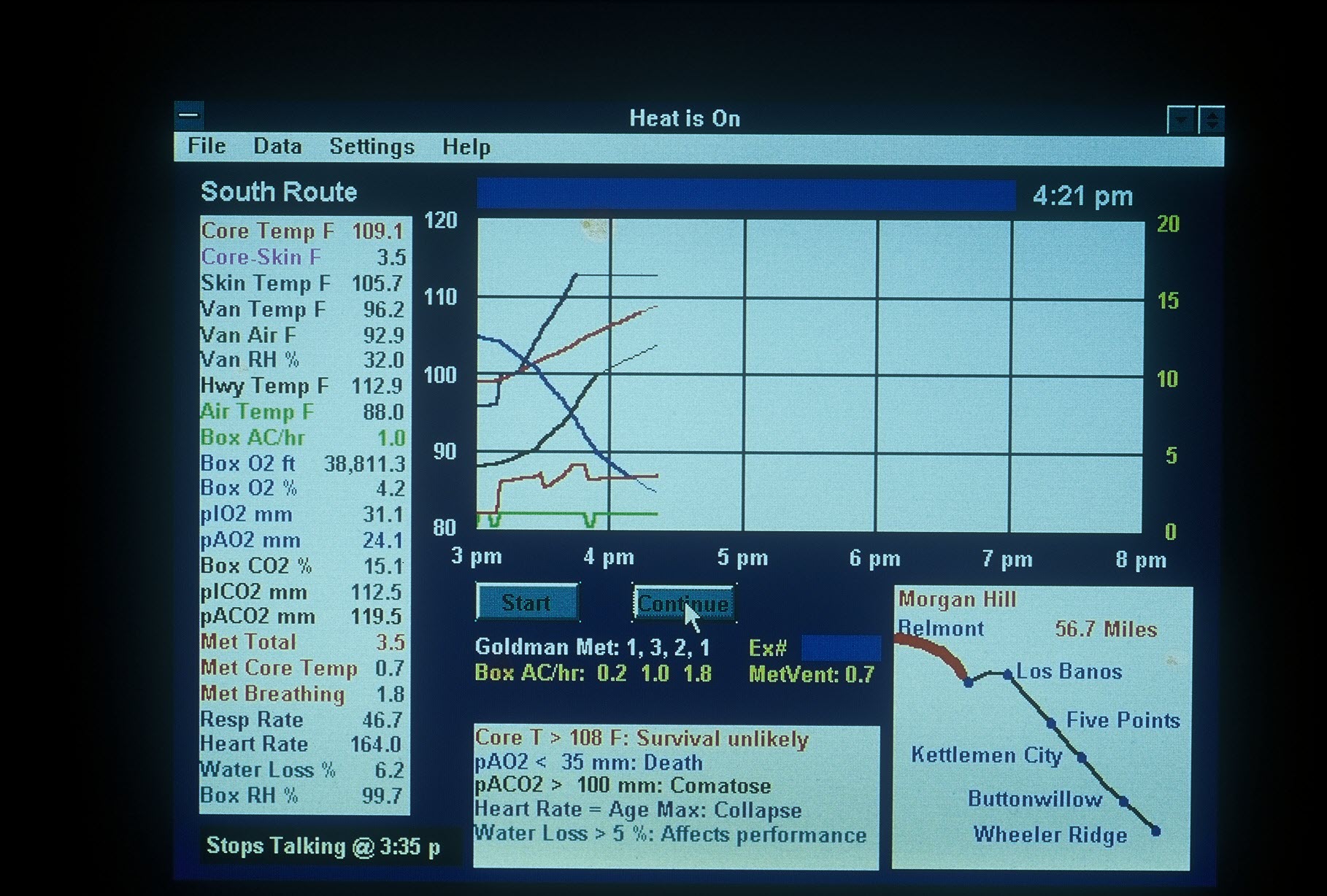
This is the output of Berry’s model that was projected on a large screen in the courtroom. The left box shows data calculated for a man in a box in a van driving from San Jose to Los Angeles on a hot sunny day. The center picture plots the key parameters using the same colors as in the right box. The lower right box displays the progress on the route. The bottom box shows critical body conditions as they occur.
Computerworld and Microsoft selected Berry’s model as one of 24 finalists out of 1300 entries for the 1993 Windows World Open where it won the overall “People’s Choice Award.” Microsoft nominated me for a Smithsonian Award.
Drought forecasting
In 1993, Berry’s company developed “CalWater” software that used curve-fits to historical, annual streamflow and tree-ring data to estimate future annual streamflow for the Sacramento River Index. It accurately predicted the recovery from the drought in California in 1993 and predicted a longer-term drought would return in 2020.
Professional Achievement Award
In 1996, the University of Nevada Alumni Association presented Berry with its Professional Achievement Award. Winterberg wrote that Berry was his best student.
Artificial intelligence applications
From 1996 through 2000, Berry’s company applied mathematical artificial intelligence methods developed for weather forecasting to the valuation of single-family homes. In side-by-side testing against other home valuation methods, Berry’s method proved significantly superior.
Climate Change
Since 2001, Berry has focused on the climate change problem. Climate change is intimately tied to his knowledge of cloud physics, numerical modeling, meteorology, weather modification and management of government weather modification research. He has self-funded his climate research since 2001.
Climate Change and statistical inference
In 1974, Berry’s panel of eminent statisticians concluded the problem of determining the effect of cloud seeding was the most difficult statistical problem they had encountered.
Today, global warming alarmists and even university professors claim human emissions cause climate change. They base their conclusion, not on proper statistics, but on their feelings. In climate change studies, no one can repeat experiments, or have control experiments, or do double-blind studies. Their conclusions are not valid scientific conclusions.
Montana
Berry moved to Bigfork, Montana, in 2008, and continued his involvement in the climate debate. Berry led the successful Montana fight to stop the “Our Children’s Trust” climate lawsuit in the Montana Supreme Court. Berry’s testimonies stopped several climate bills from passing in Montana’s legislature.
Berry maintains close interaction with many other climate scientists via the Internet and professional meetings.
Berry began his self-funded website (edberry.com) in 2009 to educate and inform the public about climate science. He is experienced in communicating with the general public and with other scientists. He has many subscribers to his climate website.
Citations
Berry’s main publications are listed on ResearchGate.net. His professional publications continue to gather citations from new publications by other authors.
Athletic achievements
During his professional career, Berry has been very active in athletic competitions.
After graduating from Caltech, Berry spent the summer training under Ed Parker in his first “gang of 8” Kenpo Karate class in Altadena, California. The most valuable part of the training was how to fall. Parker’s training allowed Berry, years later, to endure two serious falls on his back onto concrete with absolutely no injury.
When a graduate student at University of Nevada, his athletic performance in a wide variety of events won him a membership in the elite Sigma Delta Psi national athletic honorary society. Very few people have achieved this level of athletic performance. Sigma Delta Psi members include Astronaut Ed White, Dr. Hatfield, super-athlete Norm Hoffman, Harvey Wray, Dr. Robert Gordon, Scott Hurley, Bill Ruschel, and Thomas Cureton.
As a competitive small-boat sailor, Berry and his wife, Valerie, as crew, beat Olympic sailors and won Gold Medals in the 1974 CORK-Kingston, Ontario. They also won North American and US National Championships.
In the 1990’s, Berry placed in the USA top 10 age-group run-bike-run events. In the 2000’s, he placed in the top 3 in international senior track competition for races 100, 200, 400, and 1500 meters.
Berry began Concept 2 rowing in 2012. He holds world records for age-group 80-89, lightweight, for 100 m and one-minute, and is second in the 500 m by only one second.
